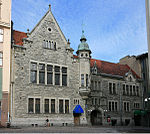Fabianinkatu 17
Art Nouveau architecture in HelsinkiNational Romantic architecture in FinlandResidential buildings completed in 1901

Fabianinkatu 17 is a national romantic-art nouveau building in central Helsinki. Built in 1900–1901 to a design by the architectural firm of Gesellius, Lindgren and Saarinen, it was originally a block of flats, but became increasingly used for offices and was for many years known as the Doctors' House (Finnish: Lääkäreiden talo). In 1953 Agronomiliitto, the Finnish Association of Agronomists, bought it, and it is now called Agronomitalo (Agronomy House).
Excerpt from the Wikipedia article Fabianinkatu 17 (License: CC BY-SA 3.0, Authors, Images).Fabianinkatu 17
Fabianinkatu, Helsinki Kaartinkaupunki (Southern major district)
Geographical coordinates (GPS) Address External links Nearby Places Show on map
Geographical coordinates (GPS)
| Latitude | Longitude |
|---|---|
| N 60.165472222222 ° | E 24.950055555556 ° |
Address
Agronomitalo
Fabianinkatu 17
00130 Helsinki, Kaartinkaupunki (Southern major district)
Finland
Open on Google Maps









